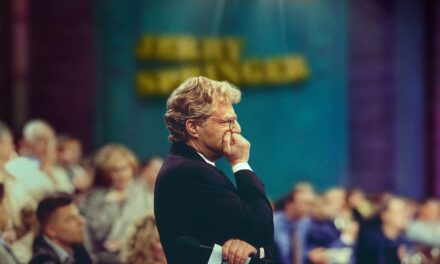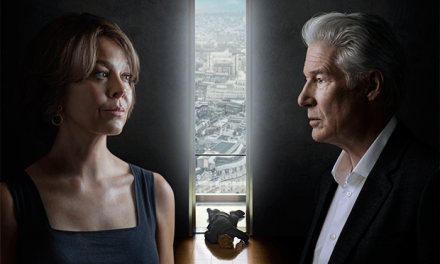Dancing on the Edge, the five-part BBC2 series whose final episode will be broadcast on Monday, has all the hallmarks of a late-period Stephen Poliakoff artefact: sumptuous settings; deep focus shots revealing a wealth of period detail; an Expressionist use of colour with lots of vibrant, Meaningful Red; a camera that lingers on black and white photographs; mouthwatering scenes of feasting that bring together unlikely combinations of people; and the looming shadow of fascism. So far, so familiar. But predictability maketh the auteur and Poliakoff’s latest extravaganza has been anticipated and analysed by Britain’s television commentariat with almost as much relish as a new film by Lynch or Tarantino; The Guardian, for example, has been running an online episode-by-episode guide to the programme. The question is: is Poliakoff’s drama worthy of the hype?
There’s no doubt that Poliakoff has written an impressive array of distinctive television plays in recent years; but even Robin Nelson, in his recent, mostly affirmative book about Poliakoff, expresses concerns about the sentimentality and lack of dramatic plausibility he detects in some of the writer’s work. Certainly, since his return to television in the late 1990s with such elegant and off-centre offerings as The Tribe (1998) and Shooting the Past (1999), the doyen of BBC quality drama has divided the critics like no other auteur around.
 Dancing on the Edge follows the ups and downs of a black jazz band – an interesting focus for Poliakoff, whose dramas seldom feature black actors – that quickly becomes the talk of early 1930s London. The band’s rise to fame is assisted by the charismatic music journalist Stanley Mitchell (played brilliantly by Matthew Goode, whose appearance, speech and mannerisms here strikingly recall Damian Lewis in Poliakoff’s earlier Friends and Crocodiles). Things take a darker turn, how
Dancing on the Edge follows the ups and downs of a black jazz band – an interesting focus for Poliakoff, whose dramas seldom feature black actors – that quickly becomes the talk of early 1930s London. The band’s rise to fame is assisted by the charismatic music journalist Stanley Mitchell (played brilliantly by Matthew Goode, whose appearance, speech and mannerisms here strikingly recall Damian Lewis in Poliakoff’s earlier Friends and Crocodiles). Things take a darker turn, how ever, when Establishment corruption and racism rear their ugly heads. In this sense, the drama recalls Poliakoff’s 2009 film Glorious 39, in which the crookedness of ‘pro-appeasement’ parliamentarians on the eve of the Second World War becomes increasingly apparent (Poliakoff’s view of Britain’s role in that war as progressive permeates his oeuvre; it’s not a view that I share – but let’s leave that geopolitical
ever, when Establishment corruption and racism rear their ugly heads. In this sense, the drama recalls Poliakoff’s 2009 film Glorious 39, in which the crookedness of ‘pro-appeasement’ parliamentarians on the eve of the Second World War becomes increasingly apparent (Poliakoff’s view of Britain’s role in that war as progressive permeates his oeuvre; it’s not a view that I share – but let’s leave that geopolitical  debate to one side for now). Stanley gets one over on the Nazis when he invites Louis Lester (Chiwetel Ejiofor), the band’s pianist, to perform at the German embassy; but in Dancing, as in Glorious 39, it’s not just the German elites that are rotten and in Monday’s finale we will discover, I suppose, just how far the web of corruption extends. Donaldson (Anthony Head) already looks like a bad egg and the American mogul and freemason Masterson (John Goodman) is looking increasingly shifty (although I have a feeling that this could be a red herring).
debate to one side for now). Stanley gets one over on the Nazis when he invites Louis Lester (Chiwetel Ejiofor), the band’s pianist, to perform at the German embassy; but in Dancing, as in Glorious 39, it’s not just the German elites that are rotten and in Monday’s finale we will discover, I suppose, just how far the web of corruption extends. Donaldson (Anthony Head) already looks like a bad egg and the American mogul and freemason Masterson (John Goodman) is looking increasingly shifty (although I have a feeling that this could be a red herring).
The lingering camera shots and snail’s pace narrative progression of Dancing on the Edge confirm Poliakoff as the master of ‘slow television’ (to borrow Amy Holdsworth’s phrase). In fact, notwithstanding Louis’s getaway scenes in the fourth episode, Dancing on the Edge has crawled along, at times making The Jewel in the Crown look like The Bourne Identity. For some critics, this is frustrating. Mark Lawson, for example, complains that Poliakoff’s leisureliness seems to have become an auteurist indulgence which is not motivated by any diegetic requirement. That may be so; but in an age of turbo-capitalism when what Nelson identifies as ‘flexiad’ aesthetics are so dominant in film and television, I welcome Poliakoff’s change of pace, his attempt to stop the flow of what Adorno called film’s ‘relentless rush of facts’.
 Much of what happens in Dancingon the Edge is implausible from a realist perspective. In episode three, for example, the band’s singer Jessie (Angel Coulby) is subjected to twists of fate worthy of a Hardy novel. And then there’s the question of language. Here, as in most of Poliakoff’s television dramas, the dialogue is markedly repetitious, stiff and sterile. Barely five minutes pass without one character declaring another to be ‘interesting’, ‘extraordinary’ or ‘important’; yet in the absence of almost any character exposition or backstory, viewers are left with few clues as to why these adjectives pertain. And for a drama that pays so much attention to period detail, the language is oddly anachronistic. To hear Pamela (Joanna Vanderham) lament that she ‘can’t be there’ for her creepy brother Julian (Tom Hughes) is disorientating because, to echo Lawson’s criticism above, there seems to be no narrative rationale for the inclusion of such a contemporary phrase. In light all of this, it is difficult to resist the conclusion – and some commentators have given up trying – that Poliakoff simply cannot write.
Much of what happens in Dancingon the Edge is implausible from a realist perspective. In episode three, for example, the band’s singer Jessie (Angel Coulby) is subjected to twists of fate worthy of a Hardy novel. And then there’s the question of language. Here, as in most of Poliakoff’s television dramas, the dialogue is markedly repetitious, stiff and sterile. Barely five minutes pass without one character declaring another to be ‘interesting’, ‘extraordinary’ or ‘important’; yet in the absence of almost any character exposition or backstory, viewers are left with few clues as to why these adjectives pertain. And for a drama that pays so much attention to period detail, the language is oddly anachronistic. To hear Pamela (Joanna Vanderham) lament that she ‘can’t be there’ for her creepy brother Julian (Tom Hughes) is disorientating because, to echo Lawson’s criticism above, there seems to be no narrative rationale for the inclusion of such a contemporary phrase. In light all of this, it is difficult to resist the conclusion – and some commentators have given up trying – that Poliakoff simply cannot write.
But perhaps there is more to it than that. It is tempting to read into the clichéd, frigid superficiality of Poliakoff’s stilted dialogue a Gatsby-esque critique of bourgeois alienation and emotional repression, although this analysis doesn’t quite work, since almost all of Poliakoff’s characters – good and bad – tend to talk the same way. In a more general sense, however, the reticence about expressions of interiority does, I think, serve a potentially valuable critical function, disrupting television drama’s conventional recourse to psychological realism and character ‘depth’. For me, there is something refreshing about characters who refrain from laying bare every aspect of their own, or others’, inner lives. Television fictions – particularly soap operas, legal and police dramas – are so full of characters feverishly explicating their reasons, histories and motives that to escape from such torrents of ratiocination can come as a welcome relief and even introduce an element of mystery. After four episodes of Dancing on the Edge, we have learned next to nothing about the backgrounds or motives of the main characters; but for me this adds to the enigma of it all.
In fact, my concerns about Poliakoff relate not so much to plausibility or writing style as to social and political representation – especially in connection to class. The problem is not so much that Poliakoff often writes about toffs rather than workers (after all, there are plenty of television dramas featuring working-class characters). It has more to do with the ways in which ordinary people are portrayed. Too often in Poliakoff plays, working-class people either serve as angelic helpers for powerful men (like Stella in 2006’s Gideon’s Daughter) or appear as hooligans intent on wreaking havoc – see, for example, Caught on a Train (1980), Bloody Kids (1980), The Tribe (1998), Friends and Crocodiles (2005) and Joe’s Palace (2007).
While there are some sympathetic working-class characters in Dancing on the Edge – notably Stanley and his assistant Rosie (Jenna-Louise Coleman) – Stanley’s mother is a bovine comic butt and when he is on the run from the police, Louis is crashed into by an aggressive working-class boy on a bicycle who shouts ‘watch out you bastard’ at him (although the accident is clearly the boy’s fault). The hoi polloi on the streets, it seems, are almost as unpleasant as those beastly Germans.
That said, there’s nothing quite so beautiful as Dancing on the Edge anywhere else on British television at the moment. The decision to broadcast it on BBC2 rather than BBC1 may be an indication that Poliakoff no longer has the industrial clout that he did a few years ago; nevertheless, I hope that the present drama is not – as is being rumoured in some corners of the Internet – Poliakoff’s television swan song. Poliakoff’s work may have its faults, but it is considerably more arresting than most contemporary British television fiction. So roll on Monday for some more ‘interesting’, ‘extraordinary’ and dare I say ‘important’ drama…
Stephen Harper is Senior Lecturer in Media Studies at the University of Portsmouth. He has published many articles on British television drama and documentary, television and film images of war and cultural representations of mental distress and is the author of the books Madness, Power and the Media(2009) and Beyond the Left: The Communist Critique of the Media (2012).





